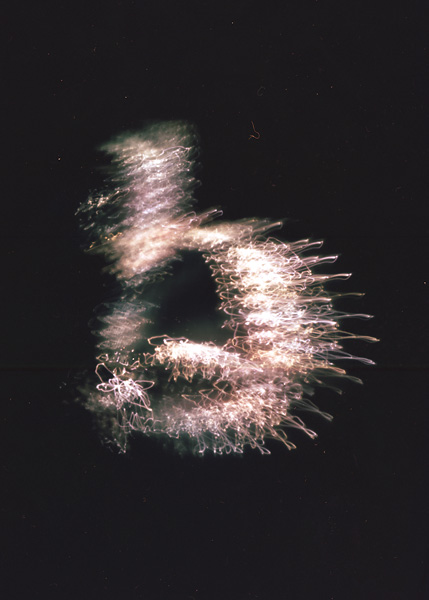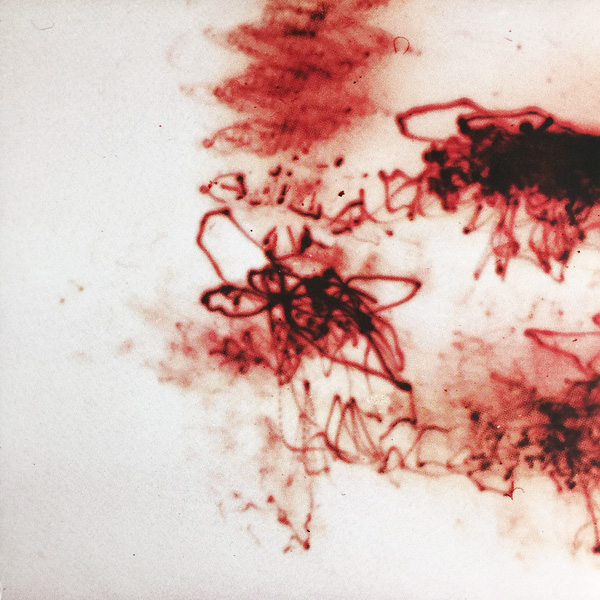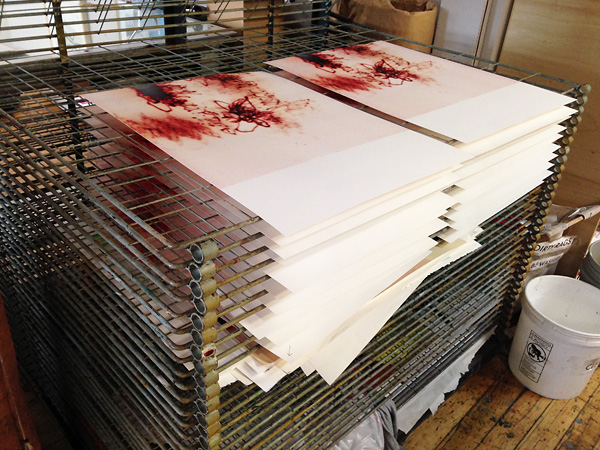
This is a pinhole photograph of Jason Stein playing the bass clarinet while wrapped in rope lights at Constellation on February 19th. A friend (thanks, Radu!) helped me develop the color film by hand. My goal here, in short, was to translate the musician’s body into a form of visual data. Everything happened so quickly in those first few weeks of the project – you can read about the early stages of this collaboration in my previous blog entry.
The next step was to figure out how to use this photograph toward the final print for Ten x Ten. Although I had all the information I needed, the image itself looked like a caricature. It still vaguely resembled a human figure in profile, which diverted attention from the motion embodied in the light streaks. I wanted to move away from literal depiction and arrive at something a little more personified, an awareness of the musician’s gestures without using a recognizable photograph of his body. I talked with Jason Stein about his choice of chance operations and procedures in the musical composition, which he loosely based on some of the methods employed by John Cage. This led me to browse images of Cage’s visual art, which often included mapping and charting in addition to chance operations.

After trying to add a grid or a graph or another kind of mapping device to the photograph, nothing seemed powerful enough to divert attention from the quaint figure. I decided to crop and enlarge the bottom left corner: the knotted mass that represented the musician’s hands. This section of the photograph fascinated me. With its gestural air, it was the only portion that deviated from the swaying parallel lines throughout the rest of the image. Once isolated, the cropped area became a vague floating mass of tangled streaks. But it wasn’t a portion so small as to lose the sense of controlled movement. I decided to reverse the colors: the bright rope lights in a dark room became dark streaks on a white background. I wanted to depart from true photographic representation and to depict something that loosely resembled a cardiograph or an EEG. In the spirit of improvised collaboration without getting too heavy-handed on my part, I decided that this image alone would be enough.

One of the master printmakers at Spudnik Press Cooperative, Colin Palombi, showed me the best way to reproduce a photograph via halftones. Although my original negative was relatively monochromatic, there was a greenish haze surrounding the figure. This created a certain amount of depth in the image. We printed the three color channels digitally, and Colin burned them onto screens for testing. I had trouble predicting how the three color layers would mix due to the varying ink transparencies combined with the halftone pattern registration. We tried a few different color samples. I kept a few of the swatches in my sketchbook, pictured here. For obvious reasons, I wanted a color that resembled flesh. We got interesting results, but at this stage of the process, none of them possessed the vitality I anticipated.

At the next meeting, I brought large digital halftone printouts to use toward creating the final screens. Printing Apprentice Walker Kampf-Lassin, and Executive Director Angee Lennard performed a number of tests on the screens. After a few setbacks, we finally achieved the desired result with pure yellow, dark red, and then black ink. The 18”x18” print exhibited a depth that was present in the original 4×5 negative. It also contained some of the artifacts that came along with the process: dust on both the film and the flatbed scanner, scratches and splotches, and a blank spot from one the halftone sheets.



The final screen print, Somaphony, has that lo-fi look often found in MRI and ultrasound images. The print will be on display at the final Ten x Ten release event coming up in September, along with nine other captivating screen prints created through improvised collaborations between musicians and artists.


